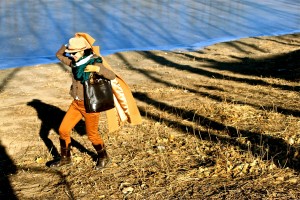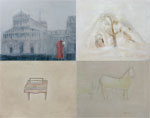Archive for August, 2013
2013 in Beijing Gulistan古丽斯坦个展 “忆-潜痕”北京马奈草地美术馆”
Sunday, August 4th, 2013忆·潜痕
——Gulistan古丽斯坦作品展题记
国家当代艺术中心专家委员会委员、中国美协理事、《美术》杂志执行主编 / 尚 辉
和大部分艺术家热衷于描绘现实不同,Gulistan古丽斯坦喜爱表现记忆。但她不是叙述记忆中储存的人物与事件,而是试图捕捉记忆的时间长度。如果说,她画面描写的与记忆有关的物象只是事件的发生点,那么,她要抒写的则是这个发生点抵达此刻的距离。那悠悠的逝去的时光,才是她想真正揭示的世界。
和许多女性艺术家沉迷于曝露私密、张扬隐晦不同,Gulistan古丽斯坦描写的那些值得记忆的物象,既是自我成长的踪影,也是人类文明曾经的繁华。舞鞋,钢琴,经书,这些曾传递过她青春体温的物品,却交错呈现出佛龛、壁画、教堂。这些物象,与其说是她曾经爱抚过的物品,毋宁说是她从这些个人的故事里钩沉的消褪在时间里的人类文明记忆。那些依旧残存着她的脂香的舞姿与旋律,飘散的却是丝绸之路悠长遥远的沙漠驼铃、岩壁粉彩和边关戍月。其实,她描绘的那些时光长度早已超出自己生命的体验。
和那些总是力求画得清晰明朗的艺术家不同,Gulistan古丽斯坦总是从此刻起笔而追溯远古。她画的是褪色,是岁月沧桑不时在打磨的那些楞角、光泽和触痕。对于一个画家而言,也许思想的深刻、观念的睿智,都比不了一层色调、一袭线条和一种笔触给予他的兴奋与温暖。Gulistan古丽斯坦最让我们难以忘怀的画面,不是她刻画了什么,而是那些温婉轻柔的米灰色调唤起我们的记忆。她能把这种色调把握得如此熨帖,仿佛是从记忆之维里抽出的旋律,幽微虚幻而带着淡淡的忧伤。
和那些一味追赶后现代文化的前卫艺术家不同,Gulistan古丽斯坦老是躲开网络时代的图像侵袭。像追忆过往的时光一样,她的绘画语言也是在回归古典中探寻艺术的现代品质。她的那些微妙沉潜的画面,不仅始终弥散着欧洲中世纪的建筑、壁画、法器等图形元素,而且汲取了早期文艺复兴湿壁画的绘制技艺,以丙烯和油彩的混合追摹那种古朴的绘画性。她用最纯净的炭笔素描和乳液淡彩,在记忆之沟里寻觅浑混的意象,笔痕的稚拙、涂鸦的畅快、覆盖的沉潜,透露的都是那些冰冷的镜头所无法传递的只属于她的文化混血与品性人格。她是在本能冲动和古典技艺中探寻现代主义的直觉理念。
所谓记忆,在病理学上,就是那些在脑沟里形成的弯弯曲曲的凹痕,是这些凹痕在人们不经意的时刻释放出伴着情感旋律的图像碎片。这些潜伏的踪影,带给个体的是生命的年岁,带给人类的是历史的长河。如果没有记忆,生命和历史都会失去时间的刻度。Gulistan古丽斯坦描绘的正是这种不断唤起我们生命与历史意象的记忆潜痕。
2013年7月23日于北京22院街艺术区
Recall – Faint Traces
– Preface to the Exhibition of Works by Gulistan
AUTHOR: MEMBER OF THE EXPERT COMMITTEE OF NATIONAL RESEARCH CENTER FOR CONTEMPORARY ART, MEMBER OF CHINA ARTIST ASSOCIATION, AND EXECUTIVE CHIEF EDITOR OF ART MAGAZINE/SHANG HUI
As an artist who devotes to express memories, Gulistan sets herself apart from the majority of artists of her generation who are dedicating in depicting reality. However, what she depicts are not the persons or matters living in her memory, but the attempts of tracing the time length of the memories. If the images in her artworks were merely tipping points of those happened events, what her expression is the path from that moment till this moment.. The days lingered are the authentic world that she tries to reveal.
It was those memorable remarks, being part of herself grown-up traces and the reminisce of past prosperity of human civilization, differentials her from other feminine artists who indulge in exposing privacy and advocating obscurity. The dancing shoes, piano keyboards, scripture classics… why do these articles that accompanied her in her youth appear with the niches for a Buddhist statue, frescos and churches? These articles are the faint traces of the past human civilization rather than her personal attachments. The graceful dance and rhymed melody remained with her grease incent, while drifting away was the traces for the camels along the distant Silk Road, frescos on the walls, and moon on the boards, which are actually beyond her personal experience of her life span.
Different from those lucidity pursuers in art, Gulistan keeps tracing the ancient days through her painting brush’s end. She shows the vestiges being worn away by time. What excites painters or make them feel warm is not a profound thought or wise idea, but the color tones, lines, and styles of drawing. We may forget the images of Gulistan’s works, but we will never forget the soft and plaintive ash-gray tone that evokes our memories. She harmonizes the tone with the conception perfectly, as though she composes the melody reserved in her memory, with a mirage and a touch of sadness.
Gulistan is a survivor of the image invasion in the Internet age, which sets her apart from the avant-garde artists who always run to catch up the postmodern culture. As her recollecting the past time, she also explores the modern quality of arts in classicism by making her subtle works pervaded by the European elements of the Middle Age such as architecture, frescos and musical and other instruments, deriving the painting skills for the frescos of the early Renaissance and pursuing primitive simplicity with the combination of propylene and paint. She appoints her most pure charcoal sketches and paintings as fairies to look for the misty images in her memory. Through her painting style, we can understand her unique cultural hybridity and personality, which the camera lens cannot capture. What drives her to seek for the philosophy of modernism in the classical art is her instinct.
What is memory? In pathology, memory is the twisty indents in the sulcus, which are image fragments with the melody of emotion released unwittingly by human. They draw the annual rings of a person, and compose the history of human. If there is no memory, the history and our life shall lose its division. What Gulistan depicts is the fainted traces that continuously evoke our images in our lives and history.
As on July 23, 2013, at 22 International Art Plaza



![[Gulistan's signature]](/images/gulistan_signature_small.jpg)
